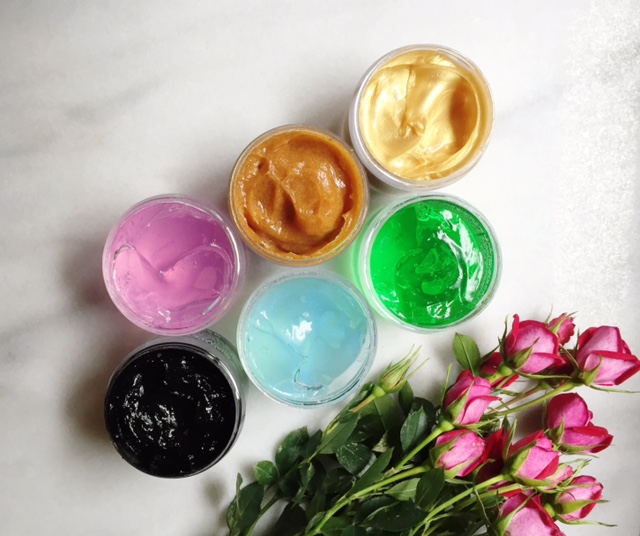

Masks are quickly becoming one of my favorite skincare treatments.
I’m not sure if my new attitude is a product of my environment–masks are insanely popular in Asia–or if I’m just putting more emphasis on self care, but in any case, my mask base is growing quickly.
I recently splurged purchased the ultra popular brand Peter Thomas Roth at Sephora; but I didn’t just buy 1 mask.. I bought the entire mask vault. It contains 6 masks:
- 24k Gold Mask
- Blue Marine Algae Mask
- Irish Moor Mud Mask
- Pumpkin Enzyme Mask
- Cucumber Gel Mask
- Rose Stem Cell Mask
What more could you want, right? They’re all beautiful.. but do they work?
Actually, that’s a great question, isn’t it? How the heck can anyone figure out which masks are good and which are trash?
To be honest, I feel the same way about facials at spas; How can you be sure of what you’re paying for? Is it really worth it?
Masks, by category, are not something that customers tend to be very loyal to, so manufacturers are more likely to mark masks way up and probably skip a few steps in the science and formulation department along the way. Scary, right?
For me that just means I can put blind trust in the manufacturer; I really need to do my own homework. It’s a lot of work, but hey, that’s skincare!
Also, that’s what I’m here for. Hopefully I can start to take a little bit of work out the equation, by introducing what I’ve learned along the way. I’ll dive even deeper into tips and tricks with each blog about the 6 different PTR masks and their efficacy.

Step 1: Define the Goal
What are you trying to accomplish with your mask? Each mask can only do so much in and of itself–it’s just a single treatment after all, and skincare is the culmination of hard work and good habits over time.
Determine what you are trying to accomplish with the mask, so that you can mask sure that your goal is reasonable (attainable). Here–for the record–is what you really can expect: Mask results are immediate, but temporary (except perhaps in the case of bee venom masks, which have shown some long-term effects potentially due to the fact that venom stings slightly, bringing additional blood to the area immediately, resulting in longer-term benefits).
If you have a big event coming up (like, say, the Victoria’s Secret show) then it makes sense to use masks in the days weeks leading up to the event. Otherwise, it’s a better to create a daily regimen, because again, skincare is the culmination of dedication and hard work over time.
Step 2: Choose the Type of Mask
Masks can range a lot in what they do and how they’re made. The general categories are:
- Sheet Masks
- Creams
- Exfoliants (chemical and physical)
- Peel-offs
Some masks will fit your lifestyle or preference more than others. For example, creams are great for those with dry or aging skin. Sheet masks come in many shapes, materials and forms (literally) and might not be the most comfortable choice. Exfoliants can be overly irritating to those with sensitive skin.
Step 3: Check the Ingredients
But the choices don’t stop there. When you’re looking at a mask, you want to choose one with known (read: well-researched, effective) ingredients for whichever skincare category you’re shopping in. That means:
- For anti-aging masks, look for: Retinoids, vitamin C, AHAs, B vitamins, peptides and antioxidants
- For acne-fighting and pore-reducing masks, look for: kaolin, sulfur, AHAs
In addition to the key ingredients, a good mask needs penetrators to help those key ingredients get deep into the skin. The penetrator typically used is propylene glycol or another form of glycol, and for more “natural” masks the penetration enhancers might be jojoba oil or squalane.
Other penetration enhancers include charged particles called ions, supersaturated solutions, liposomes, vesicles, smaller size of particles in general, and application of techniques like ultrasound (Current Drug Delivery, 2005) (source).
Step 4: Do Your Part–Wait it Out
The best formulated mask in the world still won’t work if used improperly. A good rule of thumb is to wear the mask for 20 minutes (unless it’s a glycolic acid or AHA mask, in which case you should follow the directions) before washing off or removing. Using the mask any longer than 20 minutes won’t provide any additional benefits.

Takeaways: How to Choose and Use Face Masks
You might be asking yourself (as I did), so what’s the point? If the results are temporary and one has to do so much work to determine if the mask will be effective or not, why uses masks at all?
Again, masks are a great way to prepare for an upcoming event because they make visible, targeted improvement to the skin with results that last for several days to weeks.
If you’re as into self-care as I am, masks might make their way into your nightly routine, so that your skin is always looking fresh, plump and visibly improved. Just don’t overdo it with the AHAs–chemical and physical exfoliants should never be used lightly (or rather, should be used very lightly).
That’s all the general tips and tricks I have for today, but don’t think all the mask info stops there: there’s a lot more on the way. I thought this would be a good intro to this week’s reviews and a simple guide for those interested. Feel free to ask questions below!
Gentle Reminder: If you like this type of content, support it! Scroll to the top of the page and enter your email in the right-hand side bar to keep seeing more content like this. This blog contains affiliate links, like the ones below. Buying or clicking-through on the products helps support the content ? Enjoy!

